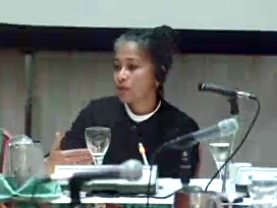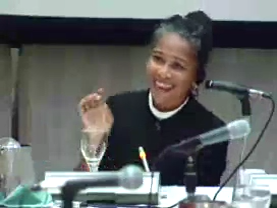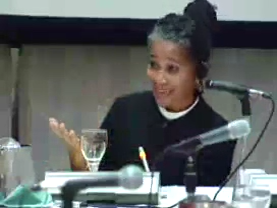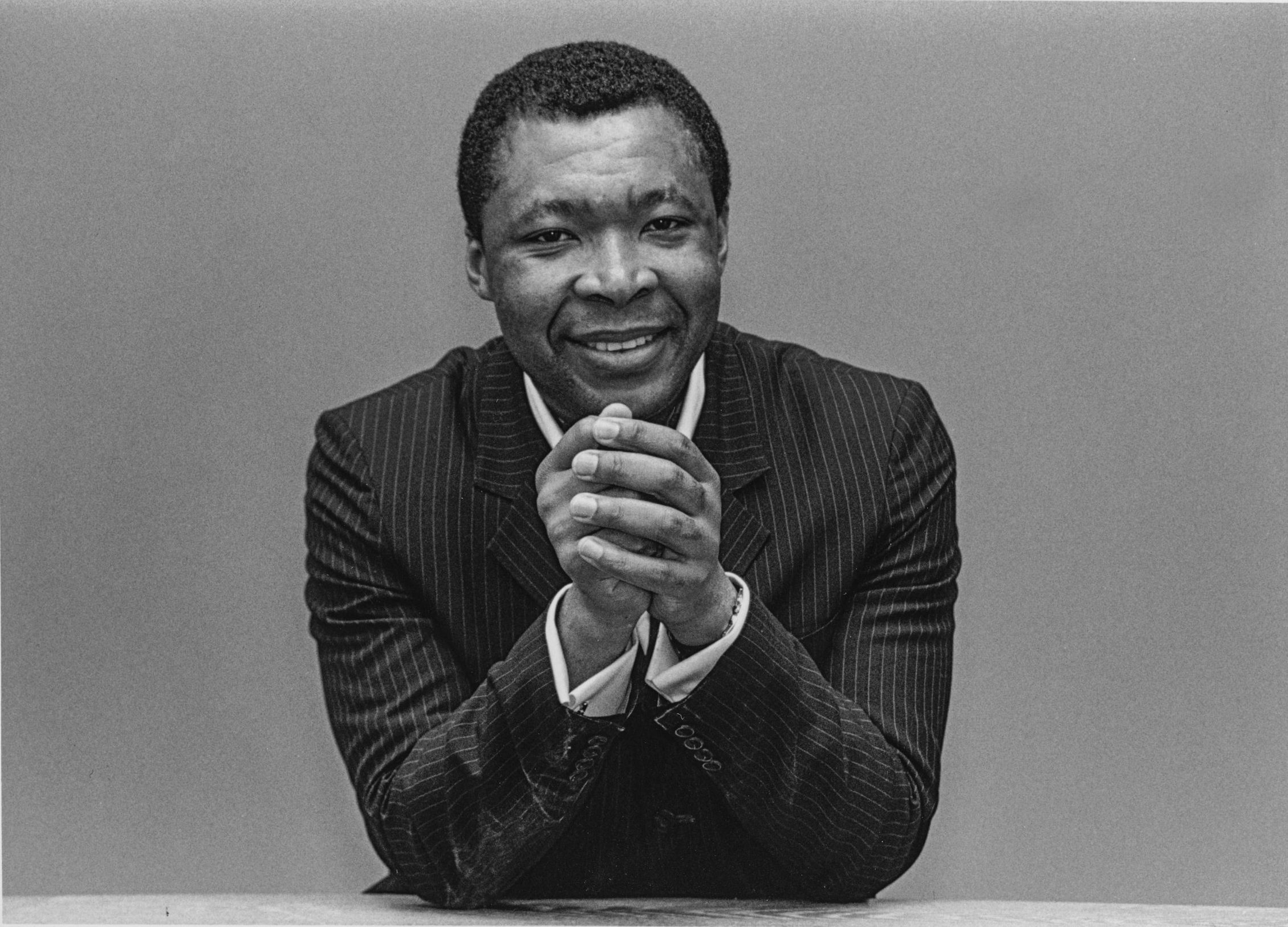Paradise, Primitivism, and Parody
When I received the invitation to this workshop, I wrote back to Documenta asking which Petrine Archer-Straw they wished to attend, the London-based academic concerned with primitivism, or the Jamaican curator of exhibitions. Like so many Caribbeans, my professional life is fragmented. I needed to consider what side of my "double consciousness" to present.1 But, despite my concerns for chasms and compartmentalization, my work was known on both sides of the Atlantic. This recognition of old and new world scholarship sparked a memory of my first postgraduate year in London. Back then, I could not understand why, as a newcomer to art history, modern art and its primitivism were so familiar. I questioned the ease with which my Caribbean background afforded me an understanding of primitivism, and the extent to which I could read into and play into its fiction. It was around the time of this surreal "big hair party" (fig. 1) that I discovered my inner voice and I learned to write my thoughts in a bold typeface that distinguished my academic and poetic selves. I found that sometimes I could recognize when images were alien to my culture and I could critique them from my gut. I am having a similar experience of déjà vu with Caribbean créolité, a dynamic hierarchical interface of race and culture, our visual arts, and créolité’s links with European primitivism. I sense the shadow of the primitive lurking in paintings, gyrating to our music, and punctuating our speech. I recognize the game of hide and seek, the bobbing and weaving and the occasional glimpses as I rummage through research notes, but more usually through my memories and desires. It is a trail that spans past and present and calls for an examination of both the black identity and the Western psyche, but more importantly, it calls for an examination of our sense of loss and desire for otherness.2 So today, in keeping with this introspective approach, I want to consider how primitivism as an aspect of European modernism has influenced our research and expression, as artists and as definers of Caribbean culture. I am grateful that this workshop allows this opportunity to explore a long-held curiosity more rigorously.
In this paper, I want to join my writings about primitivism in 1920s Paris3 with similar identity issues that also developed in the Caribbean (fig. 2). I want to trace how primitivism continues to influence our definitions of self and even our notions of créolité, and, how this poses problems to the concept of a creole community. Using my exhibition work, I will refer to a handful of writers and artists, including the British colonialist Harry Johnston; the exiled avant-garde writer Nancy Cunard; the Jamaican sculptor Edna Manley; and some younger artists mainly from the English-speaking Caribbean. This paper may seem short to make such leaps and bounds across ideas, eras, and continents, but I hope it resonates with those of us whose identities hinge on this kind of hopscotch, and that it offers a visual sense of the layers beneath the white skinned—black masked and black skinned—white masked creole personality.
Negrophilia is the word I use to talk about avant-garde interest in black culture. It stems from the French negrophilie, which crudely translates as "niggerlover." During slavery, the term negrophile derisively defined those whites who sympathized with blacks and later favored abolition.
Harry Johnston was called a negrophile when he wrote The Negro in the New World in 1910 (fig. 3).4 He theorized that Africans of the Americas and the Caribbean would advance themselves because of their mixed cultural and racial heritage. A naturalist, Johnston examined the relationship of diaspora Africans to their new Caribbean environment, noting that they were adapting quickly and becoming better suited to the terrain and climate than other races. After research, he concluded that the Caribbean's mixed background had accelerated their development, and enabled them to govern their own affairs. Despite its racism, Johnston's book was squashed — the idea of blacks controlling there own destiny was, as Johnston confessed later, "unpopular in England and almost tabued [sic] in the United States."5

© documenta archiv / Video: documenta und Museum Fridericianum Veranstaltungs-GmbH
Conversely, the Parisian avant-garde adopted negrophilia and its taboos to enhance their outsider status. The label "negrophile" placed them beyond the norms of bourgeois society. Picasso, Apollinaire, Giacometti, and many others encouraged negrophilia's negativism by introducing African forms into their work (fig. 4). In this way, their modern art and African art became linked and summarized as "primitive" (fig. 5). Abhorring the violence of World War I, they redefined themselves as modern primitives and looked to other cultures for a simpler lifestyle. Even within an urban setting, they believed that blacks were contemporary primitives representing the remnants of pre-civilized society and they cultivated black culture as an alternative to Europe's conservatism. Their flirtation with aspects of African-American popular forms such as jazz, Josephine Baker et al., was a way to rekindle their own primitive states. Black culture facilitated their regression to the primitive within (fig. 6).
These ideas soon spread from Paris to other avant-garde groups in cities such as London, Munich, and New York. Blacks, particularly ex-soldiers, also gravitated to these centers, in search of work and a freer lifestyle. They took advantage of the bias toward their culture by forming music and dance bands.
For many artists, the experience of listening to jazz or dancing le black bottom and using African imagery in their work was sufficiently stimulating. For others, travel and a burgeoning tourism provided opportunities for personal exploration and the possibility of living out one's fantasies. In the tradition of the postimpressionist Paul Gauguin in the century before, expeditions and exotic holidays authenticated the modern artist's identification with the so-called primitive. Surrealist Michel Leiris in Africa, anthologist Blaise Cendrars in Brazil, expressionist Emil Nolde in the Pacific Islands, writers William B. Seabrook in Haiti and Nancy Cunard in the Caribbean, all pursued their personal fantasies under the guise of documentary travel.
During the 1920s and '30s, the Caribbean was not short of such visitors to the region and it became a vogue muse to Europe. They came in search of the primitive, not recognizing the stowaway hidden in their luggage, secreted in their books, buried amongst their jewelry, and concealed within their thoughts. Their aim was renewal and regeneration and a simpler idyllic lifestyle, but their perceptions of black culture were based on atavistic stereotypes (fig. 7).
Nancy Cunard epitomized the negrophile of the 1920s. A shipping heiress, her interest in black culture and relationships with black men caused disinheritance and estrangement from her family. When asked about her liking for black people, she mused:
Why love the slave
The "noble savage" in the planter's grave
... I nature and men,
Answer you: "Brother ... instinct, knowledge ... and then
Maybe I was an African one time."6
Cunard's career as an activist for black causes culminated in the publication of her anthology Negro, an eclectic compilation that remains a definitive collection of black diaspora thought in the 1930s.7 Cunard contributed "Jamaica, the Negro Island," written during her travels in the Caribbean. It is an impassioned article which offers a detailed history of Jamaica and her perceptions of contemporary life. She records her encounters with "shoeless" people whom she calls "people of the soil" but she is completely dismissive of the plantocracy and urban elites like Marcus Garvey, who courted and feted her. Defining her experience of Jamaica, she concludes with "a certainty that comes like a voice out of the soil itself." "This island is the place of black peasantry, it must be unconditionally theirs. It belongs undividedly and by right to the black Jamaican on their land."8 Her revolutionary statement demonstrates the importance of the black man's fixity socially, romantically, and geographically within the negrophile's world view, but it is also remarkable for Cunard's color blindness, that even with her black separatist stance, she could still equate herself with black people, and that, in her mind, her primitivism gave her a common identity.
In addition to voyeurs like Cunard, the Caribbean also attracted black/diaspora artists such as Edna Manley in Jamaica, Richmond Barthe there and in Haiti, Wifredo Lam in Cuba (fig. 8). They too sought identity here, where they believed they had some cultural connection, and they also brought their preconceptions inspired by Picasso's primitivism and modernism's masks. Their art provoked racial awareness and promoted black imagery. It also expressed antipathy toward colonialism and concern for the "nonwhite" world's independence (fig. 9).
Their interests coincided with shifts in political power from colonial administrations to a growing local middle class attracted by cultural nationalist sentiments, Pan-Africanism, and the "new Negro" philosophies that swept through America's cities in the 1930s. By the 1940s, the perception of an exotic Caribbean had changed to that of an accommodating cultural hub for America and Europe, where black ideas about Africa and European primitivism could safely interact.
Antonio Benítez Rojo postulates the idea of "being" and even "becoming" as an essential option for the survival of a community with no common past.9 This notion of survival was built into a type of creole poetical discourse that informed representational politics during the 1940s. The ferment produced Caribbean intellects like C. L. R. James, Norman Manley, and later Eric Williams, who promoted political development rooted in cultural nationalism. They were supported by a "brown skin" middle class who recognized that, as a colored minority with a history that could not slot back easily into Europe or Africa, they had nowhere else to go. Their bid for political ascendancy in the pre-independence years came out of a recognition that the Caribbean would be home and they began to define that home, and their own identities, in creole terms that reflected their checkered cultural backgrounds.10 They encouraged Caribbean people to turn their vision from a mother country to a heritage that was historically African and more recently Caribbean, a unique gene pool of races that would be unified through placating mottos such as Jamaica's "Out of many, one people" or Trinidad's "Together we aspire, together we achieve."
Their defining of the larger black population that they represented was equally benevolent: the black man was framed in romantic and enlightened ideas about the "noble savage" that reflected contemporary negrophilia sentiments. This was characterized by the poetic idealization of the tropical island existence, the Spanish paradiso; and a growing interest in the craft and culture of black urban and rural peasant folk.
Edna Manley's Negro Aroused aptly reflects this admiration (fig. 10). Hewn intentionally from dark mahogany, its naked black torso supports a head thrust upward in search of a new dawn. Stylistically, Negro Aroused is linked to William Blake's romantic imagery of a renovated or resurrected man,11 but conceptually it wrestles with edenic and primordial thinking closer to the primitivists Henry Moore and Barbara Hepworth. Yet, in spite of its idealism, Negro Aroused is a constrained and even pained figure. Even without chains, its movement is frustrated by its rooted akimbo posture, suggesting that the black man's future is not born out of freedom but an irrevocable recognition of place. Norman Manley, considering how the black man might triumph over this adversity, wrote, "There is a tremendous difference between living in a place and belonging to it and feeling that your own life and destiny is irrevocably bound up in the life and destiny of that place. It is that spirit which is the most hopeful thing in Jamaica today. It is that spirit which alone encourages the development of our national consciousness."12

© documenta archiv / Video: documenta und Museum Fridericianum Veranstaltungs-GmbH
This type of cultural nationalism remained the main philosophical sentiment behind the Caribbean's artistic movements and their artistic products up to and beyond independence. As a result, Caribbean viewers still warm to such reflections of themselves, their portraits, market scenes, and landscapes, because they relate them to their history and to their daily realities. It is no accident that mainstream artists such as Jamaica's Barrington Watson, Trinidad's Bosco Holder, or the Bahamas' Max Taylor enjoy such popularity because of the overt race consciousness and nationalism of their work. This type of genre painting mixes, sometimes too easily, with a more "kitsch" tourist art which plays out the stereotypes of our island existence. Palm-strewn beaches, bustling markets, and rural areas populated with sturdy black men and sinewy women are part of the region's iconography in both high and low art forms.
The Caribbean's fostering of its intuitive artists is also instructive with regard to primitivism (fig. 11). The region's appreciation of its self-taught artists shows a deepening understanding of the roots of our people. Self-taught artists within the islands share affinities related to African art's spirituality and a reliance on an inner vision of reality. Their imagery and ideas are remarkably sophisticated given their development outside the mainstream. In Jamaica, these artists are patronized by the National Gallery, and are now sensitively, though nevertheless problematically, referred to as "intuitives." But it is also true that this "insider status" has been more readily cultivated through exhibitions such as the 1997 Redemption Songs: The Self-Taught Artists of Jamaica.13 These artists are popular with art collectors abroad, who still define them as "primitives" and still relate them to the naive tradition of Henri Rousseau.
In step with the acceptance of our self-taught artists has been the rise of a "black outsider" avant-garde. Their work is rooted in the Rastafarian and Black Power philosophies that impacted the region in the 1970s, but their awareness of art trends abroad has allowed them to pillage and parody European primitivism and modernism in a way that self-conscious audiences abroad find dangerous and exciting. Popular artists are the Jamaican Omani Ra and Barbadian Ras Akyem Ramsey, whose works share an attractive neoprimitivism that is nevertheless stridently black separatist (figs. 12, 13). History shows, however, that success for such artists hinges on how well they play into the West's ideas of otherness. As with the late Jean-Michel Basquiat, whose primitivized urban art was a craze in the '80s, like Jonah in the belly of the whale, artists can be spat out if they prove indigestible (fig. 14). Nevertheless, the popularity of these "black outsiders" serves to illustrate how the lines between the "noble savage" and the "urban savage" have blurred — one is a contemporary aberration of the other.
In the thirty years since independence, the cultural nationalism of the pre independence era has mutated into a more palatable discourse that represents the region's plurality. Globalization and its attendant postmodern sentiments have encouraged the search for a new language that better suits the region's diversity and cultural complexity.14 This new worldism is evidenced in an interest in the region's indigenous cultures, a more clearly defined sentiment for Africa, an idealization of the Caribbean environment, and an equally significant acceptance on the part of its white and brown classes to call themselves creole, and to identify with the Americas as home.15
Créolité and creolization rest easily within this new-world trend, concerned as they are with impurity,16 cross weaving, and encounters17 that can create new ways of being. And, although créolité and creolization have developed out of linguistic and literary debates, there is an equivalent search for hybrid and distinctive imagery that can express and define the Caribbean self within the visual arts. This exploration displays a self-conscious embracing of cultural memory as seen in the work of Anna Henriques, at other times it addresses contemporary regional identity in paintings like Roberta Stoddart's Black Pearls; a sense of place that can be styled in unconventional settings such as the beach scenes of Annalee Judah, and historical interventions like those of David Boxer, or even the constructed photographs of Albert Chong that straddle African traditions and European postmodern ideas of "primitive" creativity (figs. 15, 16).
Together these works share an introspection and intimacy that recognizes the self as the locus of our physical and psychic mutilation. Their beauty and mystery hinge on a collective ability to echo a sense of loss and nostalgia for an unknown past not only in the Caribbean but also the Americas. At its most poignant, this work demonstrates how African-Caribbean artists are still grappling with the region's complex cultural history and a more clear definition of the self, and in its most popular and accessible form, it presents a new and vibrantly attractive face to globalism. As Stuart Hall has aptly reflected, what was previously "thought of as dispersed and fragmented comes, paradoxically, to be the representative modern experience."18
All this may be a vogue aspect of postmodernism, but its strains still echo its primitivism antecedents and a reckless flirtation with otherness. Look carefully, and you will see how artists fill the voids in our understanding by ritualizing our culture, mythologizing the past, and packaging the horror of our history in the language and style of modernism (figs. 17, 18). Their primitivizing style is evident in the use of natural and found objects, a preoccupation with dreamscapes and monsters, an aggressive and regressive use of symbols and signage, and a reliance on childlike forms of representation (fig. 19).
No doubt much of this imagery serves to tell a story that can never be fully known, and artists can only intuit their past through an exploration of their own scarred remembrances, dull aches, and contemporary anxieties. Visually this is done with an art form that is as creolized as our speech; an eclectic mélange of styles borrowed from an all-pervasive modernism and different types of cultural expression. But, there is a continuum in our visual language with its underlying themes of primitivism that is frighteningly familiar. It is concerning, because these images seem to be projected onto our psyches rather than coming from deep within them. They fulfill a need, but they are nevertheless a fiction.
Contemporary art in the Caribbean is still the preserve of those who have mastered the balancing act of being neither black nor white, local and global, insiders and outsiders. And, it has found a haven in postmodernism's eclecticism that accommodates and even encourages this type of straddling. Unlike the iconic Negro Aroused, our artists and writers are not fixed in place. Rather, our identities are fluid and flexible enough to deconstruct the past and paint our own futures. This diverse background allows the Caribbean psyche to be all-inclusive, to keep reinventing itself and to have choices. But, unlike the negrophiles of the past, we can be more than voyeurs and tourists in this land of vacation that we inhabit. It would be good to think that the overtures we are making to Caribbean culture can be grounded in realities that go beyond modernism's styles and stereotypes, or even a longing for difference.

© documenta archiv / Video: documenta und Museum Fridericianum Veranstaltungs-GmbH
Within the visual arts, the primitive has been pervasive in our cultural nationalism, in our black separatism, and now, in our new worldism. In our exploration of the past and our need to recover that which has been lost, the primitive provides an easy shorthand, a friend in the dark to guide us through what Benítez Rojo calls the "black hole" of our plantation origins. This investigation plots the route of that descent to satisfy a curiosity about how European ideas of the primitive might have found a haven under the palm tree of Caribbean thinking. It cautions replenishing our sense of loss with imagery that plays out the fantasies of others. In music, some dancehall DJs consider this interplay "crossing over," but the intuitive ear and eye can tell when our lyrics and our images stray from the rhythms and visages of our realities to accommodate a more vulgar and grotesque travesty.
The picture is of a writer friend, my son and I
taken in a tiny French village called Lacoste visited in the 1930s by many surrealists
including Wifredo Lam
because this village had been the home of the Marquis de Sadewe lived in a house on the chateau's doorstep
in return I taught
courses about modern art and primitivism
to young Americansthey liked my son
in fact, the painting tutor said he had a perfect head
and borrowed him for an art class so that
the students could draw his skullbut at this big hair party
they made him a wig of paper locksmy son is now seventeen
he goes to what Jamaicans say is a "good" school
with kids we might now call creole
they all go to America for their holidaysmy son likes America
he also likes dancehall and art
but he keeps his hair short— Petrine Archer-Straw, 2002
Petrine Archer-Straw. Paradise, Primitivism, and Parody, in: Okwui Enwezor, Carlos Basualdo, Ute Meta Bauer, Susanne Ghez, Sarat Maharaj, Mark Nash, Octavio Zaya (ed.): Créolite and Creolization. Documenta11_Platform3. Hatje Cantz Verlag, Ostfildern-Ruit. 2003, pp.63-76.
References
1
Paul Gilroy, The Black Atlantic: Modernity and Double Consciousness (London: Verso, 1993).
2
For contemporary discussion in this regard, see Stuart Hall and Sarat Maharaj, Modernity and Difference, InIVAnnotations 6 (London: Institute of International Visual Arts, 2001).
3
Petrine Archer-Straw, Negrophilia: Avant-Garde Paris and Black Culture in the 1920s (London: Thames & Hudson, 2000).
4
See Petrine Archer-Straw, Photos and Phantasms: Harry Johnston's Photographs of the Caribbean (London: British Council, 1998), p. 10.
5
Harry H. Johnston, The Negro in the New World (London: Methuen, 1910), p. 428.
6
As cited by Ann Chisholm, Nancy Cunard: A Biography (New York: Knopf, 1979), p. 101.
7
Negro: Anthology Made by Nancy Cunard, 1931-1933 (London: Wishart & Co., 1934).
8
Ibid., p. 284.
9
Antonio Benítez Rojo, The Repeating Island: The Caribbean and the Postmodern Perspective, trans. James Maraniss (Durham: Duke University Press, 1992).
10
See Petrine Archer-Straw, "Cultural Nationalism: Its Development in Jamaica, 1920-1940," Ph.D. diss., University of the West Indies, Mona, Jamaica, 1985.
11
See David Boxer, Edna Manley: Sculptor (Kingston: Edna Manley Foundation and National Gallery of Jamaica, 1990).
12
Norman Washington Manley and the New Jamaica: Selected Speeches and Writings, 1938-68, ed. Rex Nettleford (London: Longman Caribbean, 1971), p. 15.
13
Redemption Songs: The Self-Taught Artists of Jamaica, exh. cat. (Winston-Salem, N.C.: Diggs Gallery at Winston-Salem State University, 1997).
14
See Petrine Archer-Straw et al., New World Imagery: Contemporary Jamaican Art, exh. cat. (London: National Touring Exhibitions, Hayward Gallery and Arts Council Collection, 1995), p. 15.
15
See Verene A. Shepherd and Glen L. Richards, eds., Questioning Creole: Creolisation Discourses in Caribbean Culture (Kingston: Ian Randle Publishers, 2002).
16
See Edward Kamau Brathwaite, The Development of Creole Society in Jamaica, 1770-1820 (Oxford: Clarendon Press, 1971).
17
See Kathleen M. Balutansky and Marie-Agnès Sourieau, eds., Caribbean Creolization: Reflections on the Cultural Dynamics of Language, Literature, and Identity (Gainesville: University Press of Florida, 1998), p. 5.
18
Quoted in Veerle Poupeye, Caribbean Art (London: Thames & Hudson, 1998), p. 184.
